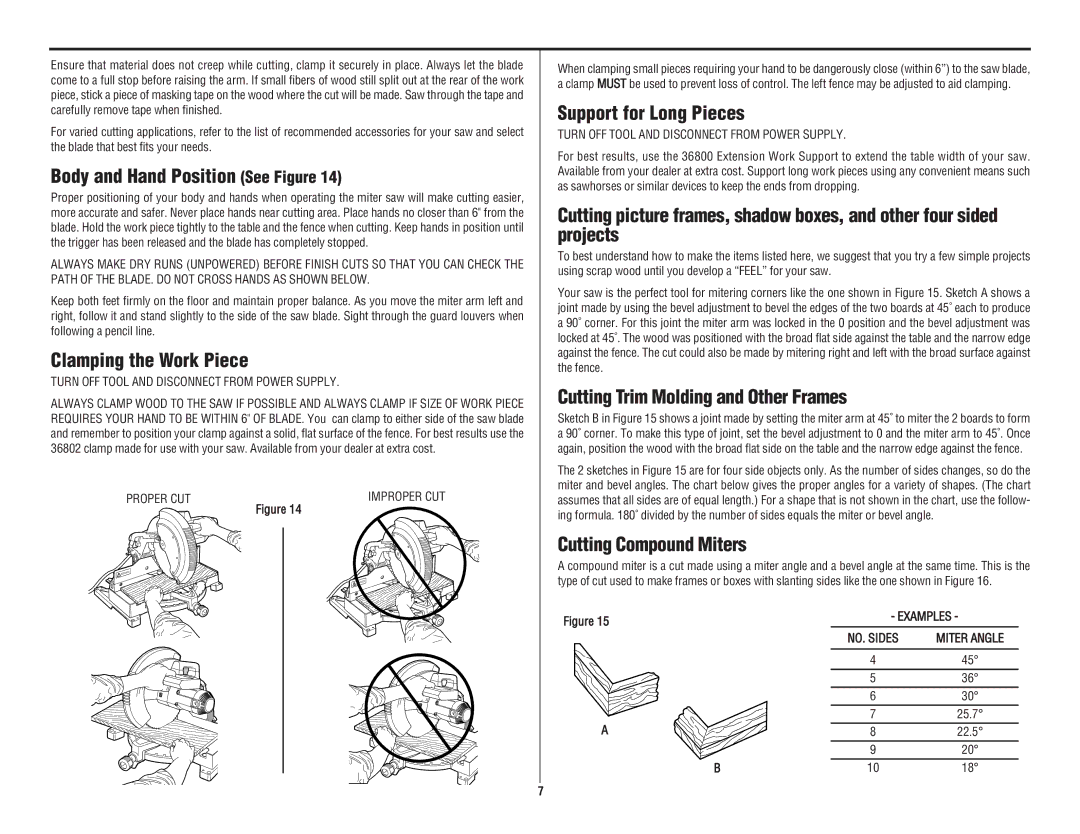
Ensure that material does not creep while cutting, clamp it securely in place. Always let the blade come to a full stop before raising the arm. If small fibers of wood still split out at the rear of the work piece, stick a piece of masking tape on the wood where the cut will be made. Saw through the tape and carefully remove tape when finished.
For varied cutting applications, refer to the list of recommended accessories for your saw and select the blade that best fits your needs.
Body and Hand Position (See Figure 14)
Proper positioning of your body and hands when operating the miter saw will make cutting easier, more accurate and safer. Never place hands near cutting area. Place hands no closer than 6" from the blade. Hold the work piece tightly to the table and the fence when cutting. Keep hands in position until the trigger has been released and the blade has completely stopped.
ALWAYS MAKE DRY RUNS (UNPOWERED) BEFORE FINISH CUTS SO THAT YOU CAN CHECK THE PATH OF THE BLADE. DO NOT CROSS HANDS AS SHOWN BELOW.
Keep both feet firmly on the floor and maintain proper balance. As you move the miter arm left and right, follow it and stand slightly to the side of the saw blade. Sight through the guard louvers when following a pencil line.
Clamping the Work Piece
TURN OFF TOOL AND DISCONNECT FROM POWER SUPPLY.
ALWAYS CLAMP WOOD TO THE SAW IF POSSIBLE AND ALWAYS CLAMP IF SIZE OF WORK PIECE REQUIRES YOUR HAND TO BE WITHIN 6" OF BLADE. You can clamp to either side of the saw blade and remember to position your clamp against a solid, flat surface of the fence. For best results use the 36802 clamp made for use with your saw. Available from your dealer at extra cost.
PROPER CUT | IMPROPER CUT |
Figure 14
When clamping small pieces requiring your hand to be dangerously close (within 6”) to the saw blade, a clamp MUST be used to prevent loss of control. The left fence may be adjusted to aid clamping.
Support for Long Pieces
TURN OFF TOOL AND DISCONNECT FROM POWER SUPPLY.
For best results, use the 36800 Extension Work Support to extend the table width of your saw. Available from your dealer at extra cost. Support long work pieces using any convenient means such as sawhorses or similar devices to keep the ends from dropping.
Cutting picture frames, shadow boxes, and other four sided projects
To best understand how to make the items listed here, we suggest that you try a few simple projects using scrap wood until you develop a “FEEL” for your saw.
Your saw is the perfect tool for mitering corners like the one shown in Figure 15. Sketch A shows a joint made by using the bevel adjustment to bevel the edges of the two boards at 45˚ each to produce a 90˚ corner. For this joint the miter arm was locked in the 0 position and the bevel adjustment was locked at 45˚. The wood was positioned with the broad flat side against the table and the narrow edge against the fence. The cut could also be made by mitering right and left with the broad surface against the fence.
Cutting Trim Molding and Other Frames
Sketch B in Figure 15 shows a joint made by setting the miter arm at 45˚ to miter the 2 boards to form a 90˚ corner. To make this type of joint, set the bevel adjustment to 0 and the miter arm to 45˚. Once again, position the wood with the broad flat side on the table and the narrow edge against the fence.
The 2 sketches in Figure 15 are for four side objects only. As the number of sides changes, so do the miter and bevel angles. The chart below gives the proper angles for a variety of shapes. (The chart assumes that all sides are of equal length.) For a shape that is not shown in the chart, use the follow- ing formula. 180˚ divided by the number of sides equals the miter or bevel angle.
Cutting Compound Miters
A compound miter is a cut made using a miter angle and a bevel angle at the same time. This is the type of cut used to make frames or boxes with slanting sides like the one shown in Figure 16.
Figure 15 | - EXAMPLES - | |
|
| |
| NO. SIDES | MITER ANGLE |
| 4 | 45° |
| 5 | 36° |
| 6 | 30° |
| 7 | 25.7° |
A | 8 | 22.5° |
| 9 | 20° |
B | 10 | 18° |
7
